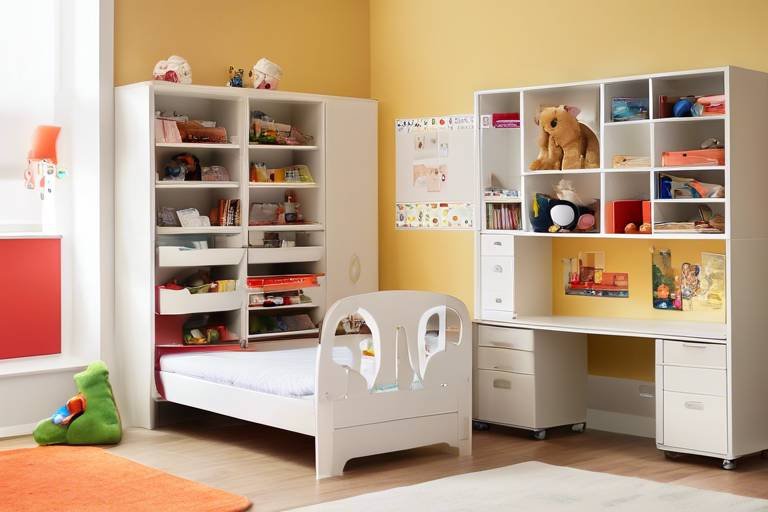Creating a Joy-Filled Atmosphere in the Family Home
In today's fast-paced world, the importance of cultivating a joyful atmosphere within the family home cannot be overstated. A home filled with joy and positivity serves as a sanctuary for family members, where they can find solace, strength, and connection. Imagine walking through your front door and being greeted by laughter, warmth, and a sense of belonging. It's like stepping into a cozy hug that wraps around you, instantly lifting your spirits. But how do we create this delightful ambiance? The answer lies in understanding family dynamics, fostering effective communication, creating shared experiences, and nurturing a positive environment.
First and foremost, it’s essential to recognize that every family is unique, with its own set of relationships and dynamics. Just like a beautiful tapestry, the threads of communication, roles, and emotional support weave together to form the fabric of family life. When these threads are strong and vibrant, they create a home that radiates joy. On the other hand, when they are frayed or tangled, the atmosphere can feel heavy and chaotic. Therefore, understanding these dynamics is the first step toward creating a joyful home.
Imagine a family dinner where everyone is engaged in lively conversation, each person sharing stories, jokes, and experiences. This is the power of effective communication. It strengthens bonds and helps resolve conflicts, transforming potential disagreements into opportunities for growth and understanding. When family members feel heard and valued, they are more likely to contribute to a positive atmosphere. But communication is not just about talking; it’s also about listening. Active listening is crucial in understanding each family member's needs and emotions. It’s like tuning into a favorite song, where every note matters. By practicing techniques that enhance listening skills, families can foster deeper emotional connections.
Moreover, nonverbal communication plays a pivotal role in how we express ourselves. Body language, facial expressions, and gestures can convey feelings and intentions that words sometimes fail to capture. For instance, a warm smile can instantly brighten someone's day, while a gentle touch can offer comfort and reassurance. Recognizing and responding to these nonverbal cues is essential in promoting a positive atmosphere. It’s like being part of a silent dance, where every movement counts.
Encouraging family members to express their thoughts and feelings openly is another vital aspect of creating a joyful environment. It’s important to establish a space where everyone feels safe to share their emotions without fear of judgment. This openness can lead to richer conversations and a greater sense of belonging. Think of it as building a fort out of pillows and blankets—once everyone is inside, they can share their wildest dreams and deepest fears, all while feeling secure and loved.
However, even in the happiest of homes, conflicts are inevitable. The key is not to avoid conflict but to navigate it effectively. Conflict resolution strategies can help maintain harmony and joy. Instead of viewing disagreements as threats to family unity, they can be seen as opportunities to strengthen relationships. Just like a storm that clears the air, resolving conflicts can lead to a renewed sense of connection and understanding.
Creating shared experiences is another cornerstone of a joy-filled home. Family activities, traditions, and rituals can enhance bonds and create lasting memories. Whether it’s a weekly game night, cooking together, or celebrating special occasions, these shared moments contribute to a sense of belonging and joy. Think of family traditions as the glue that holds everyone together, creating a sense of unity and purpose.
In addition to traditions, engaging in quality time activities reinforces relationships and promotes laughter. These activities can range from simple outings to elaborate adventures, but the key is to focus on being present and enjoying each other's company. After all, it’s not about the activity itself but the connections formed during those moments. Imagine a family hiking trip where every step is filled with laughter, stories, and shared experiences, creating a treasure trove of joyful memories.
Finally, fostering a positive environment is essential for nurturing joy within the family. A warm and welcoming space encourages happiness and emotional well-being. Simple changes, such as decluttering, adding personal touches, and ensuring ample lighting, can transform a house into a home filled with love and joy. Think of your home as a garden; the more you nurture it, the more it flourishes.
- How can I improve communication in my family? Start by practicing active listening and encouraging open dialogue among family members.
- What are some fun family activities to try? Consider game nights, cooking together, or outdoor adventures to strengthen bonds.
- How do I handle conflicts in the family? Focus on effective conflict resolution strategies that promote understanding and growth.
- What role do family traditions play in creating joy? Traditions foster a sense of belonging and create lasting memories that enhance family unity.

Understanding Family Dynamics
Family dynamics are like the intricate threads of a beautifully woven tapestry, each thread representing a unique relationship, communication style, and emotional connection. Understanding these dynamics is essential for creating a joyful atmosphere at home. It's fascinating how the roles we play within our families can significantly influence the overall vibe of our household. For instance, the nurturing parent, the rebellious teenager, or the wise grandparent all contribute to a unique blend of interactions that shape our daily lives.
Communication styles are at the heart of family dynamics. Have you ever noticed how some families communicate openly, while others seem to keep everything bottled up? This difference can create vastly different emotional climates. In families where open dialogue is encouraged, members often feel more secure and valued. They are more likely to share their thoughts and feelings, which fosters a sense of belonging and joy. On the flip side, families that struggle with communication may find themselves in a cycle of misunderstandings, leading to frustration and conflict.
Roles within the family also play a crucial part in shaping dynamics. Each member contributes to the family system, and understanding these roles can provide insight into how to foster a more joyful environment. For example, the peacemaker often steps in to resolve conflicts, while the jokester brings light-heartedness and laughter to the table. Recognizing and appreciating these roles can enhance emotional support and strengthen bonds. Here’s a quick look at common family roles:
| Family Role | Description |
|---|---|
| Peacemaker | Helps to resolve conflicts and maintain harmony. |
| Jokester | Brings humor and lightness to family interactions. |
| Nurturer | Provides emotional support and care to family members. |
| Rebel | Challenges norms and encourages change within the family. |
Moreover, emotional support is a cornerstone of joyful family dynamics. When family members feel supported, they are more likely to thrive emotionally and mentally. This support can take many forms, from a simple hug during tough times to actively listening when someone needs to vent. It's important to cultivate an environment where everyone feels safe to express their feelings without fear of judgment. After all, a family that supports each other is a family that grows together.
In summary, understanding family dynamics involves recognizing the interplay between communication styles, roles, and emotional support. By fostering open dialogue and creating a nurturing environment, families can cultivate joy and positivity. It's like watering a plant; the more care and attention you give, the more it flourishes. So, take a moment to reflect on your family dynamics. What can you do today to enhance the joy in your home?

Importance of Communication
Effective communication is the heartbeat of any joyful home. Imagine a family as a beautifully orchestrated symphony; each member plays a unique instrument, and without clear communication, the music quickly turns into chaos. When family members engage in open dialogue, they not only strengthen their bonds but also create a nurturing environment where everyone feels valued and understood. This atmosphere of openness allows for the flourishing of love and support, which are essential ingredients for happiness.
But what does effective communication look like in practice? It’s not just about talking; it’s about truly connecting. Think of it as a dance—each partner must pay attention to the other's movements to create something beautiful. This is where active listening comes into play, ensuring that each family member feels heard and appreciated. By fostering a culture of communication, families can navigate the tumultuous waters of conflict with grace and understanding.
Active listening is a critical skill that enhances communication within the family unit. It's about being present and fully engaging with what someone is saying, rather than just waiting for your turn to speak. When you practice active listening, you demonstrate that you care about the speaker's thoughts and feelings. Techniques such as maintaining eye contact, nodding, and summarizing what the other person has said can significantly improve this skill. By doing so, you pave the way for deeper emotional connections and a more joyful atmosphere.
While words are powerful, nonverbal communication often speaks volumes. Body language, facial expressions, and gestures can convey emotions that words sometimes fail to express. For instance, a warm smile can instantly brighten someone’s day, while crossed arms might communicate defensiveness or disinterest. Being aware of these cues can help family members understand each other better and create a more positive atmosphere. It’s like tuning into a secret language that everyone in the family can understand—it fosters empathy and connection.
Encouraging family members to express their thoughts and feelings openly is crucial for maintaining a joyful home. When everyone feels safe to share their emotions, it not only builds trust but also enhances the overall emotional well-being of the family. Strategies such as setting aside time for family meetings or creating a ‘feelings jar’ where everyone can anonymously share their thoughts can help in fostering this environment. Remember, it's about creating a safe space where everyone feels empowered to speak their truth.
Conflict is an inevitable part of family life, but how it is handled can make all the difference. Rather than seeing conflict as a negative force, families can view it as an opportunity for growth and deeper understanding. Effective conflict resolution strategies, such as staying calm, focusing on the issue rather than personal attacks, and seeking compromise, can help maintain harmony. By addressing disagreements constructively, families can turn potentially divisive moments into opportunities for strengthening relationships.
In conclusion, communication is the foundation upon which joyful family life is built. By prioritizing open dialogue, active listening, and effective conflict resolution, families can create a warm and loving environment that fosters happiness and emotional well-being. So, let’s take a moment to reflect: How can you enhance communication in your own family? What small steps can you take today to create a more joyful atmosphere in your home?
- Why is communication important in a family? Communication is essential as it fosters understanding, strengthens relationships, and creates a supportive environment.
- What are some effective communication techniques? Techniques include active listening, maintaining eye contact, and encouraging open expression of feelings.
- How can families resolve conflicts effectively? Families can resolve conflicts by staying calm, focusing on the issue, and seeking compromise.
- What role does nonverbal communication play? Nonverbal communication conveys emotions and attitudes, enhancing understanding and connection among family members.

Active Listening
Active listening is more than just hearing words; it's about truly understanding and engaging with what someone is saying. Imagine you're at a concert, and the music is loud, but instead of getting lost in the noise, you focus on the melody and lyrics. That's what active listening is like in family conversations. It's about tuning into the emotions and thoughts of your loved ones, creating a deeper emotional connection that can transform your home into a haven of joy.
To enhance your active listening skills, consider these techniques:
- Maintain Eye Contact: This shows the speaker that you are present and engaged in the conversation.
- Avoid Interrupting: Let them express themselves fully before you respond. This demonstrates respect and patience.
- Reflect Back: Paraphrase or summarize what they've said to show you understand. For example, you might say, "So what I hear you saying is..." This not only confirms your understanding but also encourages them to share more.
These practices can significantly improve the quality of conversations in your family. When everyone feels heard and valued, it fosters an atmosphere of trust and openness. Think of it as watering a plant; the more you nurture these conversations, the more they flourish. Active listening helps to validate each family member's feelings and experiences, making them feel important and appreciated.
Furthermore, the impact of nonverbal communication cannot be overstated. Your body language, facial expressions, and even your posture can convey just as much as your words. For instance, leaning slightly forward can indicate interest, while a warm smile can make the speaker feel more comfortable. By being mindful of these nonverbal cues, you can enhance your active listening skills even further.
In essence, active listening is about creating a safe space where family members can freely express their thoughts and emotions. It’s like building a bridge of understanding that connects hearts and minds. When everyone in the family practices active listening, it leads to a more harmonious and joyful home environment, where conflicts are resolved with empathy and love, rather than frustration and anger.
So, why not start today? Make a conscious effort to listen actively during your next family conversation. You might be surprised at how much richer and more fulfilling your interactions become!
Q: What is active listening?
A: Active listening is the practice of fully concentrating, understanding, responding, and remembering what is being said in a conversation. It involves engaging with the speaker both verbally and nonverbally.
Q: How can I improve my active listening skills?
A: You can improve your active listening skills by maintaining eye contact, avoiding interruptions, reflecting back what you hear, and being aware of your body language.
Q: Why is active listening important in a family setting?
A: Active listening fosters better communication, strengthens emotional connections, and helps resolve conflicts in a constructive manner, contributing to a more joyful and harmonious family environment.
Q: Can active listening help with conflict resolution?
A: Yes! Active listening allows each family member to feel heard and understood, which can lead to more effective and empathetic conflict resolution.

Nonverbal Communication
Nonverbal communication is like the unsung hero of family interactions; it’s often overlooked yet plays a crucial role in how we connect with one another. Think about it: when you walk into a room, the first thing you notice isn’t necessarily what people are saying, but rather how they’re saying it. The subtle cues—body language, eye contact, and even the way someone stands—can tell you volumes about their feelings and intentions. For instance, a warm smile can instantly lift the mood, while crossed arms might signal defensiveness or discomfort. Understanding these cues can help us navigate the emotional landscape of our family life more effectively.
In a family setting, nonverbal communication can act as a bridge, enhancing our verbal exchanges and fostering deeper connections. It’s not just about what we say; it’s about how we say it. When we lean in while someone is speaking, it shows we’re engaged and interested. Conversely, looking away or checking our phones can convey disinterest or even disrespect. So, how can we harness the power of nonverbal communication to create a more joyful home? Here are some key aspects to consider:
- Body Language: Your posture and movements can reflect your feelings. Open, relaxed body language invites conversation, while tense or closed-off positions can create barriers.
- Facial Expressions: A simple smile can brighten someone's day, while a frown may cast a shadow. Being aware of your expressions can help you communicate warmth and positivity.
- Gestures: Hand movements can emphasize your words, making your message clearer. However, be mindful of cultural differences in gestures, as they can have different meanings.
Moreover, nonverbal cues can also help in resolving conflicts. For example, during a disagreement, maintaining eye contact can show that you’re listening and taking the other person’s perspective seriously. On the other hand, if you’re feeling overwhelmed, it’s okay to take a moment to breathe and collect your thoughts—just communicate that with your body language, perhaps by stepping back slightly to indicate you need space.
Creating a positive atmosphere through nonverbal communication is all about being mindful and intentional. Encourage your family members to be aware of their own nonverbal signals and to interpret others' cues with empathy. By doing so, you’ll cultivate a home environment where everyone feels seen, heard, and valued, ultimately leading to greater joy and connection among family members.
Q: What is nonverbal communication?
A: Nonverbal communication includes all the ways we convey messages without words, such as body language, facial expressions, and gestures.
Q: Why is nonverbal communication important in a family setting?
A: It helps to enhance understanding and emotional connections, allowing family members to express themselves and respond to each other more effectively.
Q: How can I improve my nonverbal communication skills?
A: Practice being aware of your body language, facial expressions, and gestures. Additionally, observe how others communicate nonverbally to learn and adapt your own style.
Q: Can nonverbal communication help in conflict resolution?
A: Absolutely! Being aware of nonverbal cues can promote understanding and empathy during conflicts, helping to maintain a positive atmosphere even when disagreements arise.

Encouraging Expression
Encouraging family members to express their thoughts and feelings openly is like watering a garden; it helps relationships bloom. When everyone feels safe to share their emotions, it creates an atmosphere rich in trust and understanding. Imagine sitting around the dinner table where everyone is not just sharing their day but also their dreams, fears, and even silly thoughts. This openness fosters a deeper connection and creates a tapestry of shared experiences that can be cherished for years to come.
One effective way to encourage expression is by creating a safe space for conversations. This means establishing an environment where judgment is left at the door, and every voice matters. You could set aside a specific time each week for a family meeting, where everyone can speak freely about what's on their minds. This could be as simple as asking, “What was the best part of your week?” or “Is there something bothering you that we can talk about?”
Additionally, using creative outlets can be a fantastic way to encourage expression, especially for younger family members who might find it hard to articulate their feelings verbally. Activities such as drawing, writing stories, or even playing music can open the door to discussions about emotions. For instance, you might have a family art night where everyone creates something that represents their current feelings. This not only encourages expression but also allows for a fun, interactive experience that can lead to deeper conversations.
Moreover, it's crucial to model vulnerability. When parents or guardians share their own feelings, it sets a precedent for openness. If a parent says, “I felt really overwhelmed today, but talking about it helped,” it shows children that it’s okay to express their emotions too. This modeling of behavior can be incredibly powerful in teaching children that feelings are valid and worthy of discussion.
Finally, remember to celebrate the moments when family members do express themselves. Acknowledge their bravery in sharing feelings, and reinforce that their thoughts are valued. You could say something like, “I really appreciate you sharing that with me; it helps me understand you better.” Such affirmations can encourage more open dialogue in the future, creating a cycle of expression that enriches family bonds.
In summary, by fostering an environment that encourages expression, families can create a nurturing atmosphere where joy flourishes. It’s about more than just communication; it’s about building a culture of openness, creativity, and emotional safety that can transform a house into a true home.
- How can I encourage my children to express their feelings? Start by creating a safe space for them to share, using creative activities, and modeling vulnerability yourself.
- What are some activities that promote expression in families? Family art nights, storytelling sessions, and open dialogue during meals can be great activities to promote expression.
- Why is it important for families to express their feelings? Open expression fosters trust, understanding, and deeper emotional connections, leading to a more joyful home environment.

Conflict Resolution
Conflict is a natural part of family life, much like the occasional storm that rolls through a sunny day. It can disrupt the harmony in your home, but if handled correctly, it can also lead to growth and deeper connections. The key to effective conflict resolution lies in understanding that disagreements are not the enemy; rather, they are opportunities for learning and strengthening relationships. To navigate these choppy waters, families can employ several strategies that not only resolve the issue at hand but also foster a sense of unity and understanding.
First and foremost, it's essential to approach conflict with an open mind and a willingness to listen. This means setting aside your own agenda for a moment and truly hearing what the other person has to say. By practicing active listening, you show respect for each family member's feelings and perspectives. This can be as simple as nodding your head, maintaining eye contact, and summarizing what the other person has expressed to ensure clarity. When family members feel heard, they are more likely to engage in productive dialogue rather than defensively clinging to their own viewpoints.
Next, establishing a safe space for discussions is crucial. This involves creating an environment where everyone feels comfortable expressing their thoughts without fear of judgment or retaliation. You might set ground rules, such as no interrupting, using "I" statements to express feelings, and taking breaks if emotions run high. These guidelines can help maintain a respectful tone and keep the conversation focused on resolution rather than blame. Remember, the goal is not to "win" the argument but to find common ground and restore harmony.
In addition to communication techniques, employing a structured approach to conflict resolution can be highly beneficial. Consider using a simple framework that includes the following steps:
- Identify the Issue: Clearly define what the conflict is about. This helps to avoid misunderstandings and ensures everyone is on the same page.
- Share Perspectives: Allow each family member to express their viewpoint without interruption. This fosters empathy and understanding.
- Brainstorm Solutions: Collaboratively come up with possible solutions. This encourages teamwork and investment in the resolution process.
- Agree on a Solution: Choose a solution that everyone can support. This may require compromise, but it’s essential for moving forward.
- Follow Up: After implementing the solution, check in with each other to ensure that the resolution is working and make adjustments if necessary.
It's also important to recognize that some conflicts may require more than just a conversation. In cases where emotions run deep or issues are particularly complex, seeking the help of a family therapist or counselor can provide invaluable guidance. These professionals can offer tools and strategies tailored to your family's unique dynamics, helping to navigate conflicts in a constructive way.
Finally, remember that resolving conflicts is a skill that improves with practice. As you and your family work through disagreements, you’ll likely find that your ability to communicate effectively and empathize with one another strengthens. Over time, this can lead to a more joyful home environment where love and respect flourish, even amidst the occasional storm.
Q: What should I do if a conflict escalates?
A: If a conflict escalates, it's important to take a step back. Suggest a break to cool down and revisit the discussion later when everyone is calmer. This can prevent hurtful words and actions.
Q: How can I teach my children about conflict resolution?
A: Model healthy conflict resolution behaviors in your own interactions. Encourage your children to express their feelings and thoughts openly and guide them through the process of resolving disagreements constructively.
Q: Is it okay to disagree in front of my children?
A: Yes, it's normal to have disagreements. However, it’s essential to demonstrate respectful communication. Show your children that conflicts can be resolved positively and that differing opinions are part of healthy relationships.

Creating Shared Experiences
Creating shared experiences within the family is like weaving a beautiful tapestry, where each thread represents a unique moment that contributes to the overall picture of togetherness and joy. When families engage in activities together, they not only create lasting memories but also strengthen their bonds in ways that are often unspoken. Think of it as building a treasure chest filled with joyful moments that you can revisit anytime. Whether it’s a simple game night or an adventurous weekend getaway, these shared experiences cultivate a sense of belonging and unity that is essential for a joyful home.
One effective way to enhance family bonds is through the establishment of family traditions. Traditions serve as anchors in the fast-paced world we live in, providing a sense of stability and expectation. They can be as grand as an annual family vacation or as simple as a weekly movie night. The key is to choose activities that resonate with everyone and become cherished rituals over time. Here are a few ideas that families can consider adopting:
- Game Nights: Set aside one evening a week where everyone gathers to play board games or video games. This fosters teamwork and healthy competition.
- Cooking Together: Choose a day to prepare meals as a family. Not only does this teach valuable cooking skills, but it also encourages collaboration and creativity.
- Seasonal Outings: Plan outings that align with the seasons, like apple picking in the fall or beach days in the summer, creating seasonal memories that everyone can look forward to.
In addition to traditions, engaging in quality time activities is crucial for nurturing relationships. It’s not just about the quantity of time spent together, but the quality of those interactions. Consider activities that require participation from all family members, such as hiking, crafting, or even volunteering together. These activities can spark conversations, laughter, and a deeper understanding of one another. The joy derived from these moments often transcends the activity itself, creating a warm atmosphere filled with love and support.
Moreover, it’s essential to foster an environment where everyone feels comfortable sharing their thoughts and feelings about these experiences. After all, the goal is to create an atmosphere of joy and connection. Encourage family members to express what they enjoyed about the activities or suggest new ones they’d like to try. This open dialogue not only validates their feelings but also empowers them to take an active role in shaping family experiences.
Ultimately, the magic of creating shared experiences lies in the genuine connections formed during those moments. It’s about laughter echoing through the hallways, the warmth of togetherness, and the stories that will be told for generations to come. As you embark on this journey of creating joyful memories, remember that the best experiences are often the simplest ones—those filled with love, laughter, and the company of your family.
1. What are some simple activities to start creating shared experiences?
You can start with family game nights, cooking together, or even having a picnic at a local park. The key is to choose activities that everyone enjoys.
2. How can we ensure all family members are included in activities?
Make it a point to ask each family member for their input on activities. Rotate who chooses the activity each week to ensure everyone has a chance to share their interests.
3. What if we have different interests within the family?
That’s perfectly normal! Try combining interests or finding common ground. For example, if one loves art and another enjoys nature, consider an outdoor painting session.
4. How can we make our traditions more meaningful?
Incorporate storytelling or reflections into your traditions. For instance, during a family dinner, share your favorite memories from past gatherings to keep the spirit alive.

Family Traditions
Family traditions are like the glue that binds us together, creating a sense of belonging and identity. They are those cherished rituals that we look forward to, the little quirks that make our family unique. Think about it: when you gather around the dinner table for a special meal, or when you celebrate a holiday in a certain way, you are not just performing an act; you are weaving a tapestry of memories that will last a lifetime. These traditions can be as simple as a weekly game night or as elaborate as a yearly family reunion. What’s important is that they foster connection and joy among family members.
Establishing family traditions can be a delightful adventure. Start by identifying activities that everyone enjoys. Perhaps it’s a movie night every Friday where you all snuggle up with popcorn, or maybe it’s a Saturday morning pancake breakfast where everyone contributes a special ingredient. The idea is to create moments that everyone anticipates and cherishes. When you engage in these traditions, you are not just spending time together; you are building a reservoir of shared experiences that can bring warmth and laughter into your home.
Moreover, traditions can evolve over time. For instance, as children grow older, they might have different interests, and that’s perfectly fine! Embrace the change and adapt your traditions accordingly. This flexibility not only keeps things fresh but also shows that you value each family member's preferences and growth. Remember, the essence of family traditions lies in the joy of coming together, regardless of how they may look from year to year.
To illustrate the impact of family traditions, consider the following table that highlights some popular traditions and their benefits:
| Tradition | Benefits |
|---|---|
| Weekly Family Game Night | Encourages teamwork, communication, and laughter. |
| Annual Family Vacation | Creates lasting memories and strengthens bonds. |
| Holiday Baking Together | Promotes collaboration and the joy of sharing treats. |
| Storytelling Night | Enhances communication skills and fosters creativity. |
In conclusion, family traditions are not just about the activities themselves; they are about the feelings they evoke and the memories they create. They are a beautiful way to express love and commitment to one another. So, take the time to nurture these traditions, and you’ll find that they can transform your family home into a joyful sanctuary filled with laughter and love.
- What are some examples of family traditions? Family traditions can include weekly game nights, holiday celebrations, special meals, or annual trips. Anything that brings the family together can be a tradition!
- How can I start a new family tradition? Start by identifying activities that everyone enjoys. Discuss ideas as a family and commit to trying them out regularly.
- Can traditions change over time? Absolutely! Traditions can evolve as family members grow and interests change. Embrace the change to keep things exciting.
- Why are family traditions important? They create a sense of belonging, strengthen bonds, and provide a foundation of shared memories that can bring joy and comfort to family members.

Quality Time Activities
When it comes to creating a joyful family atmosphere, engaging in is like adding a splash of color to a black-and-white painting. These moments not only strengthen bonds but also create lasting memories that warm the heart. Think about it: when was the last time you and your family laughed so hard that your stomachs hurt? Those are the moments that matter! Whether it’s a cozy movie night or an exciting outdoor adventure, the key is to prioritize time spent together.
One of the simplest yet most effective ways to ensure quality time is to establish a regular family night. This could be anything from game nights, where laughter fills the air as you compete over board games, to cooking together, where everyone contributes to a delicious meal. The kitchen can become a delightful chaos of flour, laughter, and culinary creativity! Imagine the joy of tasting a homemade pizza with everyone’s favorite toppings, all crafted by family hands.
Additionally, consider incorporating seasonal activities that can become cherished traditions. For example, during autumn, you could have a family pumpkin carving night, where each member showcases their creativity. In winter, why not have a hot cocoa and cookie decorating evening? These activities not only bring joy but also create a sense of belonging and togetherness. Here’s a quick table to illustrate some seasonal ideas:
| Season | Activity |
|---|---|
| Spring | Gardening together |
| Summer | Beach day or picnic |
| Autumn | Apple picking or fall crafts |
| Winter | Building a snowman or holiday crafts |
Moreover, don’t underestimate the power of simple yet meaningful activities, like going for family walks or bike rides. These outings allow for open conversations and a chance to connect without distractions. As you stroll through the park or ride along a scenic route, you can share stories, dreams, and even silly jokes. It’s in these moments that true connections are made.
Lastly, it’s essential to remember that quality time doesn’t always have to be a grand event. Sometimes, it’s the little things that count. Snuggling up for a movie marathon with popcorn, reading bedtime stories, or even just sharing a meal together can foster a sense of joy and belonging. The important thing is to be present and engaged, creating an atmosphere where everyone feels valued and loved. So, what are you waiting for? Grab your family and start creating those beautiful memories today!
- What are some low-cost quality time activities? Simple activities like board games, movie nights, or cooking together can be both fun and budget-friendly.
- How often should we schedule family time? Aim for at least once a week, but feel free to make it more frequent if your schedules allow!
- What if my family members have different interests? Try to mix activities that cater to everyone’s preferences, or take turns choosing what to do.

Fostering a Positive Environment
Creating a positive environment in your family home is like planting a garden; it requires care, attention, and the right conditions to flourish. Just as a garden thrives with sunlight and water, a home filled with joy needs love, respect, and understanding. The atmosphere you cultivate can significantly influence the emotional well-being of each family member, fostering a sense of belonging and happiness. So, how can you create this nurturing space? Let’s dive into some practical strategies that can transform your home into a haven of positivity.
First and foremost, consider the physical space of your home. A well-organized and clean environment can have a profound effect on mood and overall happiness. Think of your home as a canvas; the way you arrange your furniture, the colors you choose for your walls, and even the scents you use can all contribute to the emotional palette of your household. For instance, incorporating elements such as plants can not only beautify your space but also improve air quality, which is a win-win for everyone. Here’s a quick overview of how different elements can contribute to a positive atmosphere:
| Element | Effect on Atmosphere |
|---|---|
| Color | Bright colors can uplift moods, while soft tones can create a calming effect. |
| Lighting | Natural light enhances energy levels; consider using soft lighting for a cozy feel. |
| Organization | A clutter-free space reduces stress and promotes a sense of control. |
| Personal Touches | Family photos and mementos create a sense of belonging and warmth. |
Next, let’s talk about the emotional environment. How do you make sure everyone feels heard and valued? It all starts with fostering open communication. Encourage each family member to share their thoughts and feelings, creating a safe space where everyone feels comfortable expressing themselves. This could be as simple as having regular family meetings or setting aside time during dinner to discuss everyone's day. When people feel heard, they are more likely to contribute positively to the family dynamic.
Another essential aspect is showing appreciation. A little gratitude goes a long way in reinforcing positive behavior and creating a joyful atmosphere. Make it a habit to acknowledge each other’s efforts, whether it’s helping with chores or simply being there for one another. You could create a family gratitude board where everyone can write down what they appreciate about each other. This not only boosts morale but also strengthens emotional bonds.
Lastly, don't underestimate the power of laughter and fun. Incorporating humor into daily life can lighten even the heaviest of moods. Plan family game nights, movie marathons, or outdoor adventures that encourage laughter and shared joy. These experiences not only create lasting memories but also serve as a reminder of the fun side of family life. Remember, a family that plays together stays together!
In conclusion, fostering a positive environment is an ongoing process that requires intention and effort. By focusing on the physical and emotional aspects of your home, you can create a space where joy thrives and relationships flourish. Just like that garden, with the right care, your family home can become a beautiful sanctuary filled with love, laughter, and lasting connections.
- How can I encourage my family to communicate more openly?
Start by modeling open communication yourself. Share your thoughts and feelings, and encourage others to do the same. Regular family meetings can also help. - What are some fun activities we can do as a family?
Consider game nights, cooking together, or outdoor activities like hiking or biking. The key is to choose activities that everyone enjoys. - How do I handle conflicts when they arise?
Approach conflicts with a mindset of understanding. Use active listening techniques and aim for a resolution that respects everyone’s feelings.
Frequently Asked Questions
- How can I improve communication within my family?
Improving communication starts with creating an open environment where everyone feels safe to express their thoughts. Practice active listening by giving your full attention and showing empathy. Encourage family members to share their feelings and thoughts without fear of judgment. Regular family meetings can also be a great way to discuss issues and celebrate achievements together.
- What are some effective conflict resolution strategies?
Conflict resolution involves understanding each other's perspectives and finding common ground. Start by addressing the issue calmly and respectfully. Use "I" statements to express how you feel without blaming others. Focus on solutions rather than dwelling on the problem, and be willing to compromise. Remember, the goal is to strengthen relationships, not to win an argument!
- Why are family traditions important?
Family traditions create a sense of belonging and strengthen bonds among family members. They provide opportunities for shared experiences and memories that can be cherished for a lifetime. Whether it's a weekly game night, holiday celebrations, or unique rituals, traditions can foster joy and unity, making everyone feel valued and connected.
- What activities can we do to spend quality time together?
Quality time can be as simple as cooking a meal together, going for a walk, or playing board games. Consider outdoor activities like hiking or picnicking, or even engaging in creative projects like arts and crafts. The key is to choose activities that everyone enjoys and that encourage interaction, laughter, and connection.
- How can I create a positive environment at home?
Creating a positive environment starts with decluttering your space and infusing it with warmth through decor and lighting. Encourage positivity by practicing gratitude and celebrating small victories. Foster emotional well-being by promoting kindness and support among family members, and ensure that everyone feels heard and valued.



















